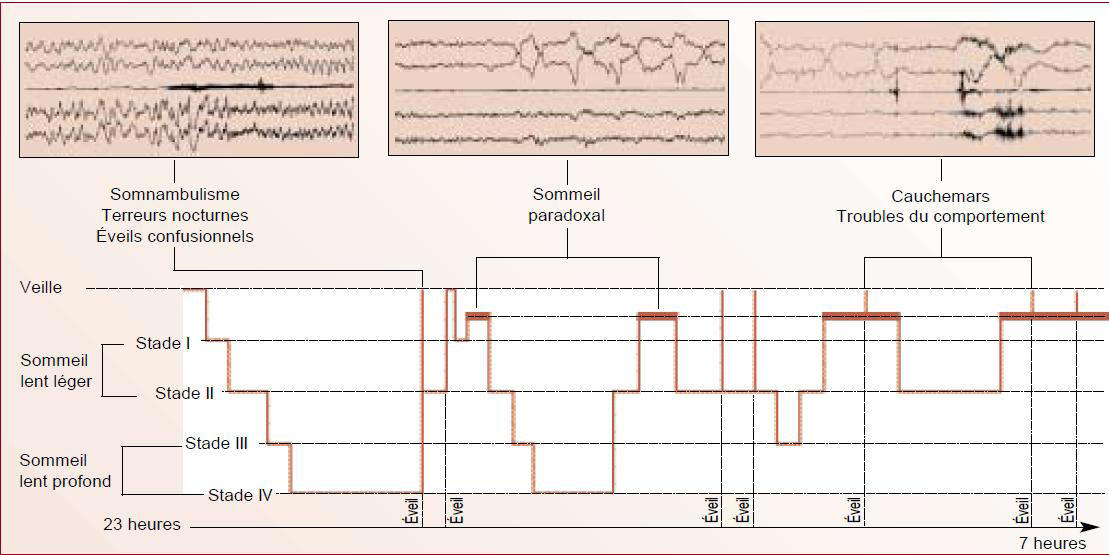Sleep Recordings in Parasomnias
NREM Parasomnia and Sleep Instability
Christian Guilleminault, MD
Stanford University, California
Over 500 subjects with NREM parasomnia were monitored during sleep since 1990 and were submitted to same monitoring protocol with adjunction of nasal cannula in 1997:
- Two subjects had epileptic nocturnal wandering,
- 9 subjects with known seizure disorder had NREM parasomnia,
- 9 subjects had serious self inflicted-life threatening accidents,
- 4 subjects with long term known history of sleep-walking had sexual related events.
All subjects presented an associated sleep disorder:
- Sleep-disordered-breathing with 56% with OSA,
- 5 subjects (1%) had RLS with PLMs and 43% with flow limitation.
We performed different testings including measurement of slow-wave-activity; cyclic-alternating-pattern, EEG analysis using wavelet program, subjects (children and adults presented an instability of NREM sleep. Therapeutic trials, including one performed with randomization to treatment by psychiatrist, show that treatment of associated sleep disorders always impacted and eliminated or greatly reduced frequency and severity of the NREM parasomnia. But the NREM instability was a chronic situation allowing the NREM parasomnia to occur when an unexpected stressful event (physiological or psychogenic) happened.
Polysomnographic Assessment for REM Sleep Behavior Disorder
Ronald Chervin, MD, MS
University of Michigan
A diagnosis of REM sleep behavior disorder (RBD) now requires polysomnographic confirmation. However, suggestive features on polysomnography -- reduction in expected tonic inhibition of muscle tone, or increased bursts of muscle activity during REM sleep -- remain largely subjective determinations for the polysomnographer to make. In 1992, LaPierre and Montplaisir proposed a more formal approach to quantify these two features of REM sleep. Available data appear to validate their approach, though it relies on visual scoring that can be laborious.
In more recent years, electronic algorithms also been developed that show promise for automatic evaluation of muscle tone during polysomnography. Such software may eventually make routine diagnosis of RBD more objective and reliable, and perhaps allow cost-effective, automatic screening for a disorder now known to predict risk for subsequent neurodegenerative disease.
Sleep markers and the utility of sleep recordings in Parasomnias
Colin Shapiro, MD, PhD
University of Toronto
There has been some debate concerning the utility of using sleep recording in contributing to the assessment of parasomnia. Without increasingly refined tools of evaluation no field progresses.
The occurrence of specific changes in the sleep patterns of depressed patients would be an example of increased electroencephalographic analysis potentially providing better biological markers.
The observation of arousals particularly from slow wave sleep with cardiac acceleration has long been observed in patients with parasomnia but the sensitivity and specificity of these features is not well described. A small study of 200 patients reviewing this issue will be presented.
Similarly, the triggers for parasomnia have been viewed in a particular light but some have recently felt that this has been without a research based validity.
A small study on 50 patients will be presented to try and highlight the difficulty in understanding ideographic phenomena.
Application of high resolution EEG to the study of parasomnias
Ruth Benca, MD, PhD
University of Wisconsin/Madison
Parasomnias are thought to represent a mixed state of waking behavior during sleep.
Recent work has demonstrated that human sleep can occur locally, which suggests that parasomnias may occur as a result of regional differences in sleep and waking brain activity.Functional brain imaging is technically difficult to perform during a parasomnia event. High density EEG (hdEEG) recordings can be used as a brain imaging tool during sleep and provide better temporal resolution than PET or fMRI, with spatial resolution comparable to PET.
We will discuss the use of hdEEG to study the neural mechanisms of parasomnias.
Pathophysiology of NREM parasomnias: Exemple of sleepwalking
Yves Dauvilliers, MD, PhD
University of Montpellier

